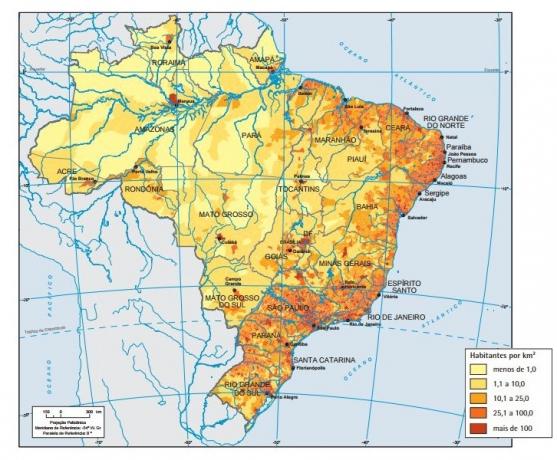Demography is the study of populations from the analysis of social phenomena related to the behavior, movement, growth or decrease of population in a region.
The purpose of a demographic analysis is to study the dynamics of a population. For this, statistical data on the population are collected and observed, and are also considered other characteristics, such as economy, culture, habits, geographic information and ethnic groups that live in the local.
Some of the main data observed to understand populations are: how their formation happens, indexes of inhabitants, birth and death rates, number of migratory movements and regions more and less populated.
In addition to the general context of a region's population, demographic analysis can also be aimed at studying specific groups, such as the elderly, indigenous people or migrants.
What are the basics of demography?
The fundamental concepts for understanding demography are:
- absolute population: represents the total number of people living in a region (neighborhood, city, state, country or world).
- Relative population (or demographic density): This index shows the distribution of population in a location. The rate is obtained by dividing the value of the total population and the size of the local area.
- Overpopulation: indication that a region has a high number of inhabitants, considering the local conditions to meet the demands of the population. The data used in this calculation are the economic, social and structural characteristics of the region.
- Demographic growth (population growth): is the population growth of a region. To determine growth, the index takes into account birth and death rates.
- vegetative growth: it is the difference between the values of birth and death rates and shows the increase or decrease of the population in a period. This data does not consider the inflow or outflow of migrants, only inhabitants who were born or died in the region are part of the calculation.
- migratory growth: rate that demonstrates population growth considering immigrants (those who arrive in the region) and emigrants (those who leave the region).
- Birth rate: is the number of births that take place in one place. The value is obtained by dividing the number of births and the absolute population.
- Mortality rate: records the number of births in a region. It is calculated by dividing the number of deaths by the absolute population.
- Child mortality rate: represents the number of deaths of children up to one year old. It is based on the number of registered births.
- Fertility (or fertility) rate: represents the average number of children per woman of reproductive age (between 15 and 49 years). This rate is an estimate based on birth averages.
- seasonal migration: record of the migratory movement that happens only at certain times of the year.
- pendular migration: migration that happens daily, when the inhabitants of a city move to work or study in a nearby city, returning at the end of the day.
- Rural exodus: is the departure of a population from the countryside to live in urban centers.
- urban exodus: represents the departure of inhabitants from cities towards the countryside of a region.
- Metropolization: it is the growth of a city that makes it the central region of a metropolitan region, where most of the population and the greatest offer of services are concentrated.
- Demetropolization: it is a phenomenon that can be a consequence of metropolization, when smaller cities in the metropolitan region also develop.
the demography of Brazil
According to data from the IBGE (Brazilian Institute of Geography and Statistics) for the year 2019, Brazil has 211 million inhabitants. The number is an estimate based on the last census carried out by the Institute in 2010.
 Demographic map of Brazil: darker areas have more inhabitants per km2 (Source: IBGE).
Demographic map of Brazil: darker areas have more inhabitants per km2 (Source: IBGE).
Characteristics of Brazilian Demography
According to IBGE, the main characteristics of Brazil's demography are:
- based on the analysis of the number of births, the population grows on average every 20 seconds;
- women represent 51.7% of the population and men are 48.3%;
- the population is mainly young (32.6% of the population is between 15 and 59 years old);
- the elderly population has increased in recent years (5.9% of the population is between 60 and 94 years old);
- life expectancy is 71 years;
- 84% of the inhabitants live in urban areas and 16% live in rural areas.
Data from the age pyramid in Brazil (Source: IBGE - National Household Sample Survey - PNAD/2018).
The demographic distribution in the regions
The Brazilian population is divided into states in this way:
- Southeast (41%)
- Northeast (38%)
- South (14%)
- North (9%)
- Midwest (8%)
the demography of the world
The main data on world demography are:
- currently the world has 7.7 billion inhabitants;
- men represent 50.4% of the population and women are 49.6%;
- the population grows approximately 1.2% per year;
- the worldwide life expectancy of 72 years;
- the elderly population has increased, currently 9% of the population is over 65 years old.
What are the most populous countries?
The 25 most populous countries concentrate 72% of the world population (they add up to 5.6 billion inhabitants out of a total of 7.7 billion).
- China (1.4 billion)
- India (1.3 billion)
- United States (331 million)
- Indonesia (273 million)
- Pakistan (220 million)
- Brazil (211 million)
- Nigeria (206 million)
- Bangladesh (164 million)
- Russia (145 million)
- Mexico (128 million)
- Japan (126 million)
- Ethiopia (114 million)
- Philippines (109 million)
- Egypt (102 million)
- Vietnam (97 million)
- Congo (89 million)
- Turkey (84 million)
- Iran (83 million)
- Germany (83 million)
- Thailand (69 million)
- UK (67 million)
- France (65 million)
- Italy (60 million)
- Tanzania (59 million)
- South Africa (59 million)
Demographic distribution on continents
The world population is divided by continents in this proportion:
- Asia (59.3%)
- Africa (17.2%)
- North and South America (13.5%)
- Europe (9.5%)
- Oceania (0.5%)
See also the meanings of:
- population;
- absolute population,
- demographic density;
- vegetative growth;
- birth rate;
- mortality rate.



